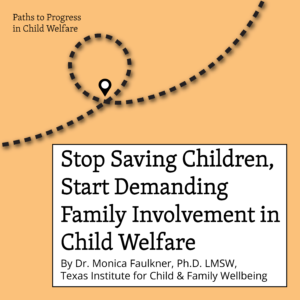Stop Saving Children, Start Demanding Family Involvement in Child Welfare
I have lost track of the number of times people have asked why the child welfare system is broken. My response stays the same: we never built the system in the first place. A system that truly improves the welfare of children would first and foremost provide support to the child’s family. Instead, we simply react to one tragedy after another with little conceptualization of how our actions have impacted families—particularly marginalized families.
Brief history of how we got here
Communities have always encountered situations where parents cannot raise their children. Historically, solutions involved kin or fictive kin taking over the role of parenting. In America, the rise of industrialization, urbanization and changing conceptions of childhood as a protected time of development resulted in a myriad of social programs focused on “saving” White children from urban poverty.
Throughout the 1900s, these programs slowly became institutionalized as legislation started requiring professionals to report suspected abuse and neglect. During the 1980s and 1990s, Black families became the focus of the child welfare system. This resulted from the mass incarceration of Black men, villainization of Black mothers as “welfare queens,” and the destruction of community-based programs, particularly housing programs.
Welfare reform in the late 1990s raised concerns about the potential consequences of children languishing in foster care because families would not be able to meet the needs of their children without public assistance. As a result, legislation passed that makes it easier to terminate parental rights and force states to operate under strict timelines to make decisions that forever alter families.
Where we are now
Across the United States, there are over 420,000 youth in foster care. The majority of these children have not experienced abuse. In fact, of those youth in foster care, 13% have experienced physical abuse, 4% have experienced sexual abuse, and 11% were abandoned. The most likely reason a child is in foster care is due to neglect, with 63% of children in care for this reason.
Definitions of neglect vary by state but neglect is often connected with parental substance use, poverty, or domestic violence. Because neglect can be interpreted very broadly, it becomes a nebulous, catch-all category that indicates a child has been removed from their home because their family is operating outside of generally agreed upon norms of the local community which might range from older children caretaking for younger siblings to marijuana use versus drinking wine.
We have created a complex system designed to protect children from abuse. But the system primarily comprises children who have not experienced abuse. Rather, they have experienced poverty or witnessed parental substance use or domestic violence at levels that the system deems unacceptable. In response to this supposed neglect, the child welfare system attempts to find them another family: a better family that more aligns with White middle-class values, norms and resources. The system claims to be acting in the child’s best interest. But often than not, the system perpetuates trauma and jeopardizes children’s futures.
Evidence that the system fails children and families
Research shows that the child welfare system fails to keep children safe, stable and well. Compared to same age peers, children in foster care have worse outcomes on every social, educational, economic, and behavioral outcome. Consider the foster care to prison pipeline, in which almost half of the youth in foster care have had contact with the juvenile justice system by the age of 17.
The rate of multi-generational involvement in the child welfare system also reveals the system’s failures. Studies show among former foster youth who are parents, 39% are themselves investigated by child protective services. Instead of addressing the root causes of systems involvement, the child welfare system perpetuates contact with harmful institutions.
Evidence produced by the child welfare system itself documents failures to meet its own stated goals. In 2000, the U.S. Children’s Bureau created a process to assess state outcomes in safety, permanency and child and family wellbeing. To date, no state has been in substantial conformity with all of the goals related to safety, permanency and child and family wellbeing.
Where can we go from here?
More hollow reforms will not correct the systemic failures in child welfare. Child welfare systems cycle through endless reforms usually instigated by the moral outrage following a child tragedy. A new leader in charge or a lawsuit against the system might spur some change, but patchwork reforms never garner enough energy to sustain efforts beyond a few years.
The uncomfortable truth is that no solution is a magic wand that will fix everything. Real change will only come when we start constructing community-based systems by deconstructing our current system. To do that, we have to be proactive rather than reactive. We have to move beyond our need to save children by shifting our work to make sure every family has what they need to be healthy and safe for their children—ensuring housing, child care and food.
Read more:
How the Child Welfare System Keeps Families Apart
Bringing Lived Experience to Child Welfare: Q&A With Leroy Berrones Soto, Jr.
Notes from the Epicenter of Texas Child Welfare
Moving Away from Mandated Reporting of Child Abuse: Q&A With Catherine LaBrenz

